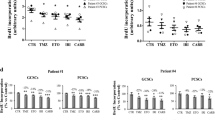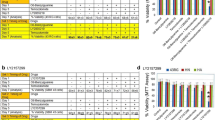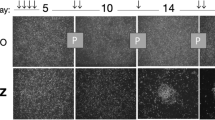Abstract
Glioblastoma multiforme (GBM) is a devastating disease with a dismal prognosis and a very limited response to treatment. The current standard of care for GBM usually consists of surgery, radiation and chemotherapy with the alkylating agent temozolomide, although resistance to this drug is common. The predominant mechanism of action of temozolomide is methylation of guanine residues although this can be reversed by methylguanine methyltransferase (MGMT) as well as other DNA repair systems. The presence of methylguanine causes abortive DNA synthesis with subsequent apoptosis. This suggests that the closer a particular cell is to S phase when it is exposed to temozolomide the more likely it is to die since repair enzymes will have had less time to reverse the damage. T type calcium channel inhibitors can stop the entry of extracellular calcium that is necessary for transit past the G1/S boundary. As a result, T type calcium channel blockers can slow the growth of cancer cells, but do not generally kill them. Though slowing the growth of cancer cells is important in its own right, it also provides a therapeutic strategy in which a T type channel blocker is administered then withdrawn followed by the administration of temozolomide. We show here that imposing this cell cycle restriction increases the efficacy of subsequently administered temozolomide in immunodeficient mice bearing various human GBM xenograft lines. We also present data that MGMT expressing GBM tumors, which are temozolomide resistant, may be rendered more sensitive by this strategy.






Similar content being viewed by others

References
Stupp R, Mason WP, van den Bent MJ et al (2005) Radiotherapy plus concomitant and adjuvant temozolomide for glioblastoma. N Engl J Med 352:987–996
Hegi ME, Diserens AC, Gorlia T et al (2005) MGMT gene silencing and benefit from temozolomide in glioblastoma. N Engl J Med 352:997–1003
Darkes MJM, Plosker GL, Jarvis B (2002) Temozolomide: a review of its use in the treatment of malignant gliomas, malignant melanoma and other advanced cancers. Am J Cancer 1:55–80
Marchesi F, Turriziani M, Tortorelli G, Avvisati G, Torino F, De Vecchis L (2007) Triazene compounds: mechanism of action and related DNA repair systems. Pharmacol Res 56:275–287
Lory P, Bidaud I, Chemin J (2006) T-type calcium channels in differentiation and proliferation. Cell Calcium 40:135–146
Gray LS, Perez-Reyes E, Gomora JC et al (2004) The role of voltage gated T-type Ca2+ channel isoforms in mediating “capacitative” Ca2+ entry in cancer cells. Cell Calcium 36:489–497
Munaron L, Antoniotti S, Fiorio Pla A, Lovisolo D (2004) Blocking Ca2+entry: a way to control cell proliferation. Curr Med Chem 11:1533–1543
Clozel JP, Ertel EA, Ertel SI (1997) Discovery and main pharmacological properties of mibefradil (Ro 40-5967), the first selective T-type calcium channel blocker. J Hypertens Suppl 15:S17–S25
Panner A, Cribbs LL, Zainelli GM, Origitano TC, Singh S, Wurster RD (2005) Variation of T-type calcium channel protein expression affects cell division of cultured tumor cells. Cell Calcium 37:105–119
Friedman HS, Colvin OM, Skapek SX et al (1988) Experimental chemotherapy of human medulloblastoma cell lines and transplantable xenografts with bifunctional alkylating agents. Cancer Res 48:4189–4195
Pollack IF, Bredel M, Erff M, Hamilton AD, Sebti SM (1999) Inhibition of Ras and related guanosine triphosphate-dependent proteins as a therapeutic strategy for blocking malignant glioma growth: II—preclinical studies in a nude mouse model. Neurosurgery 45:1208–1214; discussion 14–15
Gehan EA (1965) A Generalized Wilcoxon Test for Comparing Arbitrarily Singly-Censored Samples. Biometrika 52:203–223
Po AL, Zhang WY (1998) What lessons can be learnt from withdrawal of mibefradil from the market? Lancet 351:1829–1830
Kobrin I, Charlon V, Lindberg E, Pordy R (1997) Safety of mibefradil, a new once-a-day, selective T-type calcium channel antagonist. Am J Cardiol 80:40C–46C
Schmitt R, Clozel JP, Iberg N, Buhler FR (1995) Mibefradil prevents neointima formation after vascular injury in rats. Possible role of the blockade of the T-type voltage-operated calcium channel. Arterioscler Thromb Vasc Biol 15:1161–1165
Schmitt R, Clozel JP, Iberg N, Buhler FR (1996) Prevention of neointima formation by mibefradil after vascular injury in rats: comparison with ACE inhibition. Cardiovasc Drugs Ther 10:101–105
Schmitt R, Clozel JP, Iberg N, Buhler FR (1995) Mibefradil prevents neointima formation after vascular injury in rats. Possible role of the blockade of the T-type voltage-operated calcium channel. Arterioscler Thromb Vasc Biol 15:1161–1165
Clozel JP, Ertel EA, Ertel SI (1999) Voltage-gated T-type Ca 2+ channels and heart failure. Proc Assoc Am Phys 111:429–437
Vokes EE (1994) The promise of biochemical modulation in combined modality therapy. Semin Oncol 21:29–33
Camplejohn RS (1980) A critical review of the use of vincristine (VCR) as a tumour cell synchronizing agent in cancer therapy. Cell Tissue Kinet 13:327–335
Acknowledgments
We acknowledge C. David James, PhD for the gift of xenograft 43 MG that was used in this study.
Author information
Authors and Affiliations
Corresponding author
Rights and permissions
About this article
Cite this article
Keir, S.T., Friedman, H.S., Reardon, D.A. et al. Mibefradil, a novel therapy for glioblastoma multiforme: cell cycle synchronization and interlaced therapy in a murine model. J Neurooncol 111, 97–102 (2013). https://doi.org/10.1007/s11060-012-0995-0
Received:
Accepted:
Published:
Issue Date:
DOI: https://doi.org/10.1007/s11060-012-0995-0



